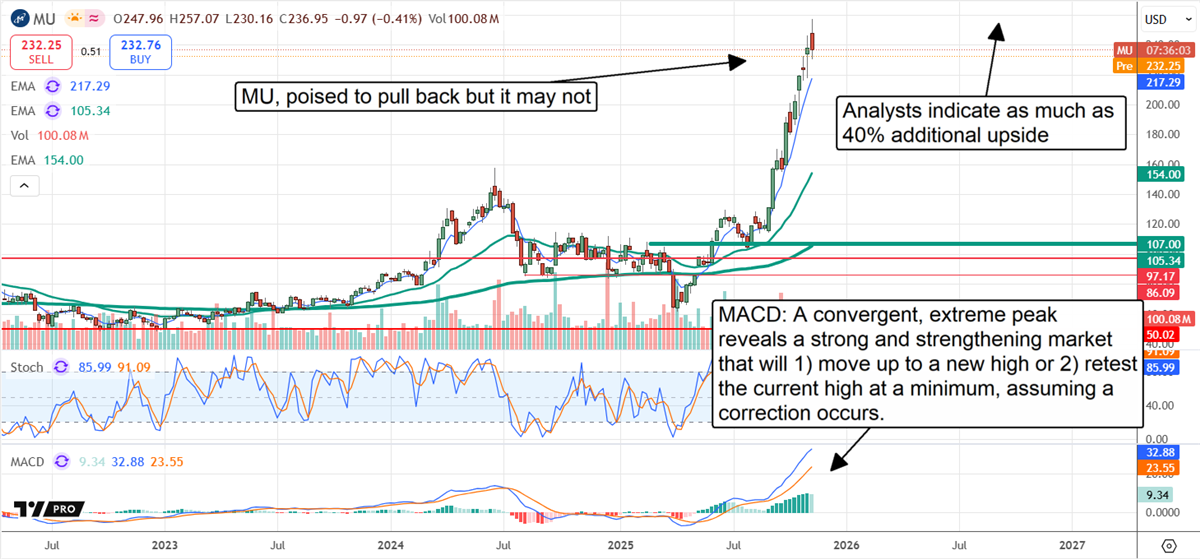If You Wait for the Dip, Micron Technology Could Leave You Behind

While concerns that the AI demand outlook is overblown and players like OpenAI will struggle to meet their commitments regarding GPUs are valid, these are bricks in a Wall of Worry built on a robust demand spike and the foundations of a multi-year memory chip supercycle.
Evidence of the supercycle lies in DRAM chipmaker Samsung’s (OTCMKTS: SSNLF) move to raise prices and Morgan Stanley's price target increase, likely followed by many more in the coming quarters.
That macro-level signal underscores a rising tide that directly benefits Micron (NASDAQ: MU), one of the few players positioned to capitalize on surging DRAM demand. Micron’s price action peaked in November and may be due for a pullback—but long-term investors should welcome that as a bullish setup.
Analysts Can't Keep Up With Micron’s Rapidly Rising Growth Trajectory
Morgan Stanley analyst Joseph Moore and team raised their price target for MU stock to $325, approximately 50% higher than their previous target.
This new forecast indicates a potential 40% upside from mid-November highs, and it is likely to be a low estimate.
In Morgan Stanley's view, the demand-driven price surge underpins an earnings forecast that will take the company into “uncharted territory from an earnings standpoint, and we think the stock has yet to fully price in the upside that's coming." Their model prices DRAM surging 50% in some cases, and has already proven to be cautious.
That thesis was reinforced almost immediately, as Samsung raised prices by 60% the next day, citing a global shortage of AI-capable HBM3E or better memory units, which are critical to the AI industry. Each GPU—whether built by NVIDIA (NASDAQ: NVDA) or Advanced Micro Devices (NASDAQ: AMD)—is constructed with a cluster of HBM memory stacks, each containing up to 12 DRAM memory dies. This design has already driven an exponential surge in demand for Micron’s products, relative to what we’ve seen so far for NVIDIA and what we expect to see from AMD when it launches the MI450 line.
The takeaway for investors is that Micron’s business is experiencing an unprecedented surge in revenue and earnings that has yet to fully take hold, and the stock price has yet to reflect it.

Micron Is A Deep Value, But the Market Isn’t Sure How Deep
Consensus estimates for earnings and stock valuation are likely triggers, and analysts will need to lift their near and long-term forecasts.
As it stands, analysts have priced in some strength for 2026 through 2028, but they don’t reflect the surge indicated by demand and pricing trends, nor have the group updated targets further out.
Micron is trading at a relatively low 14x earnings as of mid-November 2025 and approximately 12x its 2028 forecast, suggesting its multiple could increase modestly to more robust levels by 50% over the coming years, driving a significant increase in the stock price without the addition of earnings growth or outperformance.
With those in the mix, Micron’s stock price could easily rise by a triple-digit figure relative to November highs over the next few years.
And Morgan Stanley analysts are not the only ones bullish on this stock. The trends are robust, including a sharp uptick in coverage to 38 analysts, a firming sentiment with a Buy rating bias at 88%, and a price target trending higher.
The consensus lags behind the market in November, contributing to the correction outlook, but is up more than 45% over the preceding 12 months, with the high-end lifted to $325 by Morgan Stanley, and all recent revisions exceeding consensus.
Micron Is At a Peak and Poised to Pull Back... But It Might Not
Micron’s stock price reached a peak in November, which may cap gains over the next few weeks to a few months. The problem is short interest and institutional activity, which reached long-term highs in the first case and were sold on balance in the first half of Q4 in the second. Together, they create a fierce headwind for the price action that may lead to a correction.
If so, the price could fall to the $185 to $200 range before indicating support. The caveat is that analysts and retail investor trends are also solid, and may provide sufficient support to hold the market at current levels. In that scenario, MU will consolidate at or near current highs, potentially leading to new highs later this year or early in 2026.
Learn more about MU


